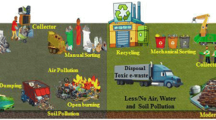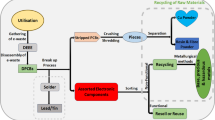Abstract
Laser induced breakdown spectroscopy (LIBS) was applied for the detection of trace elements in non-degradable part of plastics known as insoluble organic material, obtained from thermal and catalytic degradation of plastics. LIBS signal intensity for each metal measured in the test sample was unique and different. The capability of this technique is demonstrated by analyzing various trace metals present inside plastics and also compared with ICP results. The metal concentration (ppm) measured with LIBS and verified by ICP for Ag (901), Al (522), Fe (231), Co (628), V (275), Ni (558), Pb (325), Mn (167) and Cd (378) are higher than permissible safe limits.




Similar content being viewed by others
References
Achilias DS (2007) Chemical recycling of poly (methyl methacrylate) by pyrolysis. Potential use of the liquid fraction as a raw material for the reproduction of the polymer. Eur Polymer J 43(6):2564–2575. doi:10.1016/j.eurpolymj.2007.02.044
Ali MF, Siddiqui MN (2005) Thermal and catalytic decomposition of behavior of PVC mixed plastic waste with petroleum residue. J Appl Anal Pyrolysis 74(1–2):282–289. doi:10.1016/j.jaap.2004.12.010
Ali MF, Siddiqui MN, Redhwi HH (2004) Study on the conversion of waste plastics/petroleum resid mixtures to transportation fuels. J Mater Cycles Waste Manage 6:27–34. doi:10.1007/s10163-003-0102-x
Environment Protection Agency (EPA) (2006) http://www.epa.gov/garbage/plastic.htm. Accessed Sep 2008
Gondal MA (1997) Laser photo acoustic spectrometer for remote monitoring of atmospheric pollutants. Appl Opt 36:3195–3201. doi:10.1364/AO.36.003195
Gondal MA, Hussain T (2007) Determination of poisonous metals in waste water collected from paint manufacturing plant using laser-induced breakdown spectroscopy. Talanta 71:73–80. doi:10.1016/j.talanta.2006.03.022
Gondal MA, Mastromarino J (2000) Lidar system for remote environmental studies. Talanta 53:147–154. doi:10.1016/S0039-9140(00)00465-3
Gondal MA, Mastromarino J (2001) Pulsed laser photoacoustic detection of SO2 near 225.7 nm. J Appl Opt 40:2010–2017. doi:10.1364/AO.40.002010
Gondal MA, Hussain T, Yamani ZH, Baig MA (2006) Detection of heavy metals in arabian crude oil residue using laser induced breakdown spectroscopy. Talanta 69:1072–1078. doi:10.1016/j.talanta.2005.11.023
Gondal MA, Hussain T, Yamani ZH, Baig MA (2007a) The role of various binding materials for trace elemental analysis of powder samples using laser induced breakdown spectroscopy. Talanta 72:642–649. doi:10.1016/j.talanta.2006.11.039
Gondal MA, Hussain T, Ahmad Z, Bakry A (2007b) Detection of contaminants in ore samples using laser induced break down spectroscopy. J Environ Sci Health A 42:879–887. doi:10.1080/10934520701373075
Gondal MA, Hussain T, Yamani ZH, Bakry AH (2007c) Determination of elemental composition in iron slag waste using laser induced breakdown spectroscopy. J Environ Sci Health A 42(6):767–775. doi:10.1080/10934520701304443
Hamid SH, Amin MB, Maadhah, AG (1992) Handbook of polymer degradation. Editors, Marcel Decker, New York. NIST http://physics.nist.gov/PhysRefData/ASD/index.html?nist_atomic_spectra.html
Perugini F, Mastellone ML, Arena U (2005) A life cycle assessment of mechanical and feedstock recycling options for management of plastic packaging wastes. Environ Prog 24(2):137–154
Rahman F, Siddiqui MN, Redhwi HH, Ali MF (2006) Catalytic processing of waste plastics with/without petroleum resid—an economic evaluation. Energy Sources A 28(15):1353–1363
Striganove A, Sventitski N (1968) Table of spectral lines of neutral and ionized atoms. Plenum, New York
Acknowledgments
The authors would like to acknowledge the facility and financial support provided by the King Fahd University of Petroleum & Minerals, Dhahran, Saudi Arabia, through project grant SAB 2006/025 and IN 080410 for carrying out this work that has resulted in the preparation of this paper. One of the authors (M. Nasr) is thankful to KFUPM for its hospitality and permission to work at its research facilities.
Author information
Authors and Affiliations
Corresponding author
Rights and permissions
About this article
Cite this article
Siddiqui, M.N., Gondal, M.A. & Nasr, M.M. Determination of Trace Metals Using Laser Induced Breakdown Spectroscopy in Insoluble Organic Materials Obtained from Pyrolysis of Plastics Waste. Bull Environ Contam Toxicol 83, 141–145 (2009). https://doi.org/10.1007/s00128-009-9749-x
Received:
Accepted:
Published:
Issue Date:
DOI: https://doi.org/10.1007/s00128-009-9749-x




